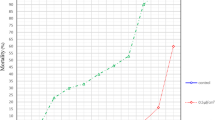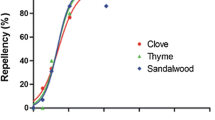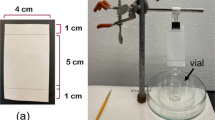Abstract
The essential oil from Amyris balsamifera (Rutaceae) and elemol, a principal constituent of the essential oil of Osage orange, Maclura pomifera (Moraceae) were evaluated in in vitro and in vivo laboratory bioassays for repellent activity against host-seeking nymphs of the blacklegged tick, Ixodes scapularis, and the lone star tick, Amblyomma americanum. Both bioassays took advantage of the tendency of these host-seeking ticks to climb slender vertical surfaces. In one bioassay, the central portion of a vertical strip of filter paper was treated with test solution and ticks placed or allowed to crawl onto the untreated lower portion. In the other bioassay, a strip of organdy cloth treated with test solution was doubly wrapped (treatment on outer layer) around the middle phalanx of a forefinger and ticks released on the fingertip. Both amyris oil and elemol were repellent to both species of ticks. Elemol did not differ significantly in effectiveness against A. americanum from the widely used repellent deet. At 2 and 4 h after application to filter paper, 827 μg amyris oil/cm2 paper repelled 80 and 55%, respectively, of A. americanum nymphs. Ixodes scapularis was repelled by lower concentrations of amyris oil and elemol than A. americanum.



Similar content being viewed by others
References
Ahmad F, Jantan I (2003) Chemical constituents of the essential oils of Goniothalamus uvariodes King. Flavour Fragr J 18:128–130
Armstrong PM, Brunet LR, Spielman A, Telford SR III (2001) Risk of Lyme disease: perceptions of residents of a lone star tick-infested community. Bull World Health Organ 79:916–925
Bates D, Maechler M (2009) lme4: Linear mixed-effects models using S4 classes. R package version 0.999375-31. http://CRAN.R-project.org/package=lme4
Bissinger BW, Apperson CS, Sonenshine DE, Watson DW, Roe RM (2009) Efficacy of the nes repellent BioUD® against three species of ixodid ticks. Exp Appl Acarol 48:239–250
Carroll JF, Solberg VB, Klun JA, Kramer M, Debboun M (2004) Comparative activity of deet and AI3–37220 repellents against the ticks Ixodes scapularis and Amblyomma americanum (Acari: Ixodidae) in laboratory bioassays. J Med Entomol 41:249–254
Carroll JF, Klun JA, Debboun M (2005) Repellency of deet and SS220 applied to skin involves olfactory sensing by two species of ticks. Med Vet Entomol 19:101–106
Carroll JF, Cantrell CL, Klun JA, Kramer M (2007) Repellency of two terpenoid compounds isolated from Callicarpa americana (Lamiaceae) against Ixodes scapularis and Amblyomma americanum ticks. Exp Appl Acarol 41:215–224
Carroll JF, Benante JP, Klun JA, White CE, Debboun M, Pound JM, Dheranetra W (2008) Twelve-hour duration testing of cream formulations of three repellents against Amblyomma americanum (Acari: Ixodidae). Med Vet Entomol 22:144–151
CDC (2002) Lyme disease. Department of Health and Human Services, Centers for Disease Control and Prevention, Ft. Collins, p 12
Childs JE, Paddock CD (2003) The ascendancy of Amblyomma americanum as a vector of pathogens affecting humans in the United States. Annu Rev Entomol 48:307–337
Dietrich G, Dolan MC, Peralta-Cruz J, Schmidt J, Piesman J, Eisen RJ, Karchesy J (2006) Repellent activity of fractioned compounds from Chamaecyparis nootkatensis essential oil against nymphal Ixodes scapularis (Acari: Ixodidae). J Med Entomol 43:957–961
Dolan MC, Maupin GO, Schneider BS, Denatale C, Hamon N, Cole C, Zeidner NS, Stafford KC III (2004) Control of immature Ixodes scapularis (Acari: Ixodidae) on rodent reservoirs of Borrelia burgdorferi in a residential community of southeastern Connecticut. J Med Entomol 41:1043–1054
Fish D, Childs JE (2009) Community-based prevention of Lyme disease and other tick-borne diseases through topical application of acaricide to white-tailed deer: background and rationale. Vector-Borne Zoonot Dis 9:357–364
Garboui SS, Jaenson TGT, Borg-Kalson A-K, Pålsson K (2007) Repellency of methyl jasmonate to Ixodes ricinus nymphs (Acari: Ixodidae). Exp Appl Acarol 42:209–215
Jaenson TGT, Pålsson K, Borg-Karlson A-K (2005) Evaluation of extracts and oils of tick-repellent plants from Sweden. Med Vet Entomol 19:345–352
Lane RS, Anderson JR (1984) Efficacy of permethrin as a repellent and toxicant for personal protection against the Pacific coast tick and the pajaroello tick (Acari: Ixodidae and Argasidae). J Med Entomol 21:692–702
McCullagh P, Nelder JA (1989) Generalized linear models, 2nd edn. Chapman and Hall/CRC, London
Paluch G, Grodnitzky J, Bartholomay L, Coats J (2009) Quantitative structure–activity relationship of botanical sesquiterpenes: spatial and contact repellency to the yellow fever mosquito, Aedes aegypti. J Agric Food Chem 57:7618–7625
Parola P, Raoult D (2001) Ticks and tick-borne diseases in humans an emerging infectious threat. Clin Infect Dis 32:897–928
Phillis WA, Cromroy HL (1977) The microanatomy of the eye of Amblyomma americanum (Acari: Ixodidae) and resultant implications of its structure. J Med Entomol 13:685–698
Piesman J, Eisen L (2008) Prevention of tick-borne diseases. Annu Rev Entomol 53:323–343
R Development Core Team (2009) R: A language and environment for statistical computing. R Foundation for Statistical Computing, Vienna, Austria. ISBN 3-900051-07-0, URL http://www.R-project.org
Schreck CE, Mount GA, Carlson DA (1982) Wear and wash persistence of permethrin used as a clothing treatment for personal protection against the lone star tick (Acari: Ixodidae). J Med Entomol 19:143–146
Schreck CE, Fish D, McGovern TP (1995) Activity of repellents applied to skin for protection against Amblyomma americanum and Ixodes scapularis ticks (Acari: Ixodidae). J Am Mosq Contr Assoc 11:136–140
Schultz GE, Peterson C, Coats J (2006) Natural insect repellents: activity against mosquitoes and cockroaches. In: Rimando AM, Duke SO (eds) Natural products for pest management; ACS Sym. Ser. 927. American Chemical Society: Washington, DC, pp 168–181
Sonenshine DE (1993) Biology of ticks, vol 2. Oxford University Press, New York
Spielman A, Wilson ML, Levine JF, Piesman J (1985) Ecology of Ixodes dammini-borne human babesiosis and Lyme disease. Annu Rev Entomol 30:439–460
Tunón H, Thorsell W, Mikinver A, Malander I (2006) Arthropod repellency, especially tick (Ixodes ricinus), exerted by extract from Aremisia abrotanum and essential oil from flowers of Dianthus caryophyllum. Fitoterapia 77:257–261
Van Beek TA, Kleis R, Lelyveld GP, de Groot AE (1989) Preparative isolation of (+)- beta-eudesmol from Amyris balsamifera. Chromatographia 3(4):126–128
Venables WN, Ripley BD (2002) Modern applied statistics with S, 4th edn. Springer, New York
Wang SY, Lai WC, Chu FH, Lin CT, Shen SY, Chang ST (2006) Essential oil from the leaves of Cryptomeria japonica acts as a silverfish (Lepisma saccharina) repellent and insecticide. J Wood Sci 52:522–526
Watanabe Y, Mihara R, Mitsunaga T, Yoshimura T (2005) Termite repellent sesquiterpenoids from Callitris glaucophylla heartwood. J Wood Sci 51:514–519
Zhang A, Klun JA, Wang S, Carroll JF, Debboun M (2009) Isolongifolenone: a novel sesquiterpene repellent of ticks and mosquitoes. J Med Entomol 46:100–106
Acknowledgments
We thank James McCrary, USDA, ARS, Invasive Insect Behavior and Biocontrol Laboratory, Beltsville Agricultural Research Center, Beltsville, MD for performing behavioral bioassays that were essential to this study. We are also grateful to USDA, ARS, Knipling-Bushland U. S. Livestock Insects Research Laboratory, Kerrville, TX for providing the A. americanum used in the study.
Author information
Authors and Affiliations
Corresponding author
Rights and permissions
About this article
Cite this article
Carroll, J.F., Paluch, G., Coats, J. et al. Elemol and amyris oil repel the ticks Ixodes scapularis and Amblyomma americanum (Acari: Ixodidae) in laboratory bioassays. Exp Appl Acarol 51, 383–392 (2010). https://doi.org/10.1007/s10493-009-9329-0
Received:
Accepted:
Published:
Issue Date:
DOI: https://doi.org/10.1007/s10493-009-9329-0




